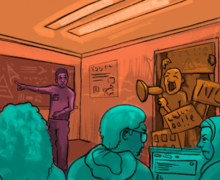Syracuse struggles on turf during 1-3 road trip
Max Freund | Asst. Photo Editor
Syracuse, which plays its home games on grass, just struggled on a road trip played exclusively on turf.
Syracuse faced a great deal of problems on its four-game road trip — an inconsistency at the goalkeeper position, not being able to muster enough clean shots and giving up goals behind a unprotected backline to save the opposing attack. But one issue that arose on its 1-3 road trip was out of SU’s control: The Orange’s transition from natural grass to turf.
When Syracuse (3-4) plays at SU Soccer Stadium, it plays on a 120- by 75-meter natural grass field. In its last four games, SU has played on varying turf fields, converting only two of its 40 shots. In its three losses, including two 4-0 losses to No. 11 Penn State and then-winless Harvard, SU was outscored 11-1.
While some players prefer turf over their home stadium’s natural grass, the Orange’s transition to the new fields caused its offense to speed up and make more errors over the last two weeks. With ACC road play beginning Sept. 20 at Boston College, a turf field, SU needs to improve on its recent turf play to get back to .500.
“You have to be more precise on turf,” head coach Phil Wheddon said, “And, honestly, that’s what got us down in our last game. We weren’t precise enough.”
Before the Aug. 30 matchup against Harvard, SU transitioned from practicing on Hookway Fields’ natural grass to Wohl Lacrosse Field and Skytop, both turf fields.
Turf creates a faster game — the ball moves quicker, the bounce can be a little different and a player’s touch has to be spot on to avoid turnovers, Wheddon said. It creates a shorter surface for players to compete on. The pitch features well-cut turf instead of varying lengths of grass, which all players would prefer in good weather, forward Kate Hostage said.
“Turf is a lot harder and grass has a lot more to give,” Laurel Ness said. “I like playing through balls and balls in the air off corners, and the grass has so much more give to it. It’s a lot better.”
But problems start to arise when the weather changes. When turf gets wet, it creates a different reaction than natural grass fields.
“The ball will skip quite a lot when it’s wet. It’ll be unreliable,” Hostage said, “It could hit a patch of mud and stop.”
Despite a familiarity with a natural grass home field, most SU players prefer turf because of its pace. Every field turf is different though, and the adjustment gives the home team an early advantage, Wheddon said.
While SU didn’t allow a goal in the first 15 minutes of play on its four game road stretch, it didn’t do much offensively. Between Aug. 30 and Sept. 9, SU registered three shots and eight fouls in its first 15 minutes of play.
“It’s more the first 15 minutes of touches that you have to adjust than the long-term situation and having it impact you that much,” Sydney Brackett said.
When players adjust to practicing on turf the days before a game, Wheddon said he has to be strategic in practice drills and how long practice is. The wear and tear from playing on multiple surfaces can make a player sore before game day. But he said the only way the Orange will improve its play on turf is with increased repetitions.
With ACC play approaching, the Orange will need to get off to faster starts to gain the early advantage.
“We have to make sure our players are ready to play on a new surface,” Wheddon said, “… the technical things let us down and we’re usually a very technical team.”
Published on September 12, 2018 at 11:11 pm
Contact KJ: kjedelma@syr.edu | @KJEdelman






